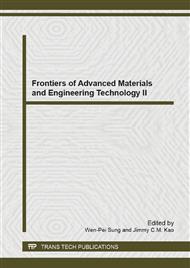[1]
Yang Mingsheng. Non-contact inductive coupling power transmission and control technology and its application [D]. Hunan University. (2012).
Google Scholar
[2]
C.S. Wang, O.H. Stielau, G.A. Covic, Design consideration for a contactless electric vehicle battery charger[J]. IEEE Transactions on Industry Applications, 2005, 52(5): 1308-1313.
DOI: 10.1109/tie.2005.855672
Google Scholar
[3]
Hou Shiying, Zeng Jianxing, Fang Yong, etc. Simulation of Active Power Filter with DC side coupling transformer[J]. Grid Technology, 2011, 08: 109-113.
Google Scholar
[4]
Zhao Biao, Leng Zhiwei, Lu Liang, etc. Design and implementation of a small non-contact power transmission system[J]. Power Electronics Technology, 2009, 01: 49-51.
Google Scholar
[5]
Sibué, J. -R., Kwimang, G., Ferrieux, J. -P., A global study of a contactless energy transfer system: analytical design, virtual prototyping prototyping, and experimental validation[J]. IEEE Transaction on Power Electronics, 2013, 28(10): 4690-4699.
DOI: 10.1109/tpel.2012.2235858
Google Scholar
[6]
Mao Changliang. Research and Design of non-contact power transmission technology[D]. Shanghai Jiao Tong University, (2008).
Google Scholar
[7]
Bieler T, Perrottet M, Nguyen V, Contactless power and information transmission [J]. IEEE Transactions on Industry Electronics, 2002, 38(5): 1266-1272.
DOI: 10.1109/tia.2002.803017
Google Scholar
[8]
D. Kacprzak, G. A. Covic, J. T. Boys, An improved magnetic design for inductively coupled power transfer system pickups[C], The 7th International Power Engineering Conference(IPEC), 2005, 2: 1133-1106.
DOI: 10.1109/ipec.2005.207077
Google Scholar
[9]
Zhou Wenqi. Characteristics and design studies of inductively coupled power transfer system[D]. Zhejiang University, (2008).
Google Scholar
[10]
Lu Qingyun. Key technologies used in deep-sea environment non-contact power transmission system[D]. Zhejiang University, (2012).
Google Scholar
[11]
J.T. Boys, G.A. Covic and A.W. Green, Stability and control of inductively coupled power transfer systems[J], IEE-Elect. Power, 2000, 147(L): 37-43.
DOI: 10.1049/ip-epa:20000017
Google Scholar
[12]
Qin Haihong, Wang Huizhen, Yan Yangguang. Principle analysis and design of non-contact loosely coupled inductive power transfer systems[J]. Power Technology, 2004, 05: 257-262.
Google Scholar
[13]
Chwei-Sen Wang, Stielau O. H and Covic G A, Load models and their application in the design of loosely coupled inductive power transfer systems[C]. Power System Technology, 2000, 2: 1053-1058.
DOI: 10.1109/icpst.2000.897166
Google Scholar


